
Combined effect of simultaneous changes in
Explanation of Solution
After the
1. If the demand and supply increase in the same proportion:
When demand and supply increase at equal rate, the equilibrium price remains unchanged but the equilibrium quantity changes. This is shown in the Figure 1. In the figure, equilibrium quantity has increased from OQ to OQ'
Figure 1
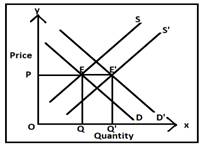
2. If the demand and supply decrease in the same proportion:
When demand and supply decrease at equal rate, the equilibrium price remains unchanged but the equilibrium quantity changes. This is shown in the Figure 2. In the figure, equilibrium quantity has decreased from OQ to OQ'
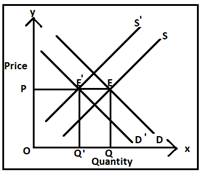
Figure 2
3. If the increase in demand is more than the increase in supply:
When the proportionate increase in the demand is greater than that of supply, then the equilibrium price increases a little while the equilibrium quantity increases greatly. This is shown in the Figure 3. In the figure, equilibrium price OP increases to OP' and the equilibrium quantity OQ increases to OQ'.
Figure 3
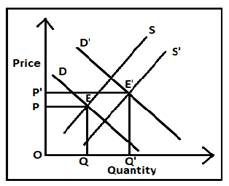
4. If the decrease in demand is more than the decrease in supply:
When the proportionate decrease in the demand is greater than that of supply, then the equilibrium price decreases a little while the equilibrium quantity decreases greatly. This is shown in the Figure 4. In the figure, equilibrium price OP decreases to OP' and the equilibrium quantity OQ decreases to OQ'.
Figure 4
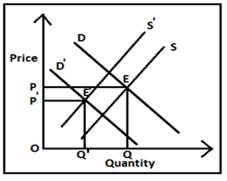
5. If the increase in demand is less than the increase in supply:
When the proportionate increase in the supply is greater than that of demand, then the equilibrium price decreases a little while the equilibrium quantity increases greatly. This is shown in the Figure 5. In the figure, equilibrium price OP decreases to OP' and the equilibrium quantity OQ increases to OQ'.
Figure 5

6. If the decrease in demand is less than the decrease in supply:
When the proportionate decrease in the supply is greater than that of demand, then the equilibrium price decreases greatly while the equilibrium quantity increases a little. This is shown in the Figure 6. In the figure, equilibrium price OP increases to OP' and the equilibrium quantity OQ decreases to OQ'.
Figure 6
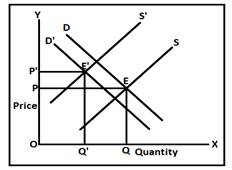
In all of the above figures,
D= Original demand curve, D'= New demand curve E= Equilibrium
S= Original supply curve, S'= New supply curve E= New Equilibrium
Introduction:
Market equilibrium take places at the momentwhen market demand and market supply become equal. This situation determines the equilibrium price, equilibrium quantity demanded and supplied also. After the market equilibrium is established, change in demand or supply as well as simultaneous changes in demand and supply at the same time affects the original equilibrium price, equilibrium quantity demanded and supplied. Sometimes these result in the establishment of a new market equilibrium.
Want to see more full solutions like this?
Chapter 3A Solutions
PRIN.OF ECON.ACCESS CODE
- In a paragraph, no bullet, points please answer the question and follow the instructions. Give only the solution: Use the Feynman technique throughout. Assume that you’re explaining the answer to someone who doesn’t know the topic at all. 8. How does monetary policy supposedly translate into changes in AD?arrow_forwardIn a paragraph, no bullet, points please answer the question and follow the instructions. Give only the solution: Use the Feynman technique throughout. Assume that you’re explaining the answer to someone who doesn’t know the topic at all. 2. Carefully explain either Keynes’ “cookie jar” motive for holding money or the “saw-toothed model’s” motive for holding a safety stock.arrow_forwardIn a paragraph, no bullet, points please answer the question and follow the instructions. Give only the solution: Use the Feynman technique throughout. Assume that you’re explaining the answer to someone who doesn’t know the topic at all. 7.Carefully explain the Fisher equation for interest rates. What insight does it provide?arrow_forward
- In a paragraph, no bullet, points please answer the question and follow the instructions. Give only the solution: Use the Feynman technique throughout. Assume that you’re explaining the answer to someone who doesn’t know the topic at all. 3. Describe the general architecture of the Federal Reserve System.arrow_forwardIn a paragraph, no bullet, points please answer the question and follow the instructions. Give only the solution: Use the Feynman technique throughout. Assume that you’re explaining the answer to someone who doesn’t know the topic at all. 1. Define money. Carefully explain the three functions of money.arrow_forwardIn a paragraph, no bullet, points please answer the question and follow the instructions. Give only the solution: Use the Feynman technique throughout. Assume that you’re explaining the answer to someone who doesn’t know the topic at all. 5.Draw the Federal Reserve System’s Balance Sheet and briefly explain each of the main (highlighted in the PowerPoints and text) components.arrow_forward
- In a paragraph, no bullet, points please answer the question and follow the instructions. Give only the solution: Use the Feynman technique throughout. Assume that you’re explaining the answer to someone who doesn’t know the topic at all. 9. What are monetary rules? How are they carried out and what is the difference between monetary rules and discretionary behavior?arrow_forwardIn a paragraph, no bullet, points please answer the question and follow the instructions. Give only the solution: Use the Feynman technique throughout. Assume that you’re explaining the answer to someone who doesn’t know the topic at all. 4. What is interest payment on reserve balances used for? How does it work?arrow_forwardA linear programming computer package is needed. As part of the settlement for a class action lawsuit, Hoxworth Corporation must provide sufficient cash to make the following annual payments (in thousands of dollars). Year 1 2 3 4 5 6 Payment 170 195 220 265 295 440 The annual payments must be made at the beginning of each year. The judge will approve an amount that, along with earnings on its investment, will cover the annual payments. Investment of the funds will be limited to savings (at 4% annually) and government securities, at prices and rates currently quoted in The Wall Street Journal. Hoxworth wants to develop a plan for making the annual payments by investing in the following securities (par value = $1,000). Funds not invested in these securities will be placed in savings. Security Current Price Rate (%) Years to Maturity 1 $1,055 6.750 3 2 $1,000 5.125 4 Assume that interest is paid annually. The plan will be submitted to the judge and, if approved,…arrow_forward
- On the 1st of April 2018, the South African National Treasury increase the value-added tax rate from 14% to 15%. This policy change had a wide-ranging impact on society. Discuss some of the benefits and drawbacks of making use of this type of tax to generate government revenue and what we may expect in terms of its impact on inflation and GDP growth within the economy. Please use some of the economics graphs to explain some scenariosarrow_forwardEskom is South Africa’s monopoly power producer which the majority of South Africans depend on. Suppose there is extensive deregulation in the power industry. What is the impact of this deregulation on the industry? Help me on discussing the new market structure as well as the impact on supply and demand. Use the relevant diagrams.arrow_forwardDiscuss the impact of exchange rate volatility on the economy and its impact on your organisation. Make use of the relevant diagrams.arrow_forward

 Principles of Economics 2eEconomicsISBN:9781947172364Author:Steven A. Greenlaw; David ShapiroPublisher:OpenStax
Principles of Economics 2eEconomicsISBN:9781947172364Author:Steven A. Greenlaw; David ShapiroPublisher:OpenStax Exploring EconomicsEconomicsISBN:9781544336329Author:Robert L. SextonPublisher:SAGE Publications, Inc
Exploring EconomicsEconomicsISBN:9781544336329Author:Robert L. SextonPublisher:SAGE Publications, Inc Microeconomics: Private and Public Choice (MindTa...EconomicsISBN:9781305506893Author:James D. Gwartney, Richard L. Stroup, Russell S. Sobel, David A. MacphersonPublisher:Cengage Learning
Microeconomics: Private and Public Choice (MindTa...EconomicsISBN:9781305506893Author:James D. Gwartney, Richard L. Stroup, Russell S. Sobel, David A. MacphersonPublisher:Cengage Learning Macroeconomics: Private and Public Choice (MindTa...EconomicsISBN:9781305506756Author:James D. Gwartney, Richard L. Stroup, Russell S. Sobel, David A. MacphersonPublisher:Cengage Learning
Macroeconomics: Private and Public Choice (MindTa...EconomicsISBN:9781305506756Author:James D. Gwartney, Richard L. Stroup, Russell S. Sobel, David A. MacphersonPublisher:Cengage Learning Economics: Private and Public Choice (MindTap Cou...EconomicsISBN:9781305506725Author:James D. Gwartney, Richard L. Stroup, Russell S. Sobel, David A. MacphersonPublisher:Cengage Learning
Economics: Private and Public Choice (MindTap Cou...EconomicsISBN:9781305506725Author:James D. Gwartney, Richard L. Stroup, Russell S. Sobel, David A. MacphersonPublisher:Cengage Learning





